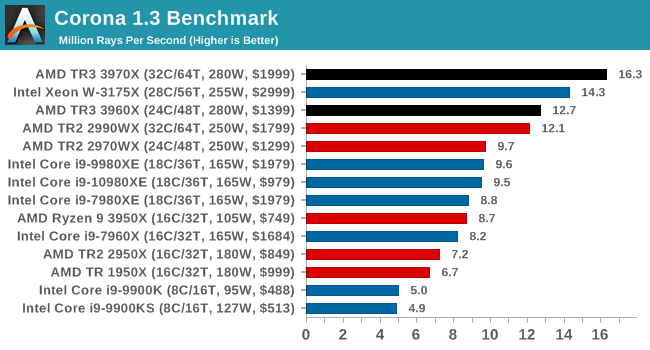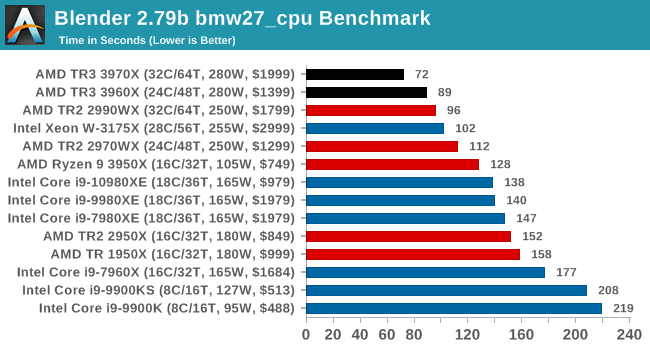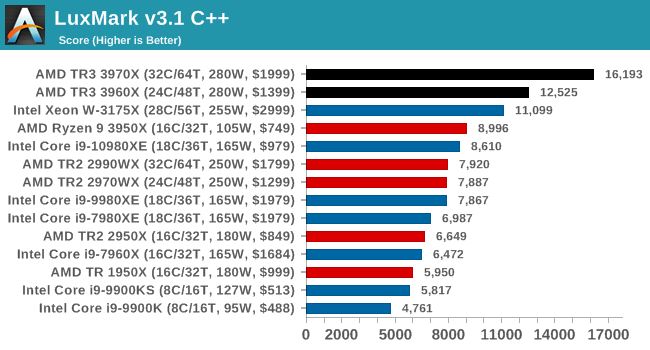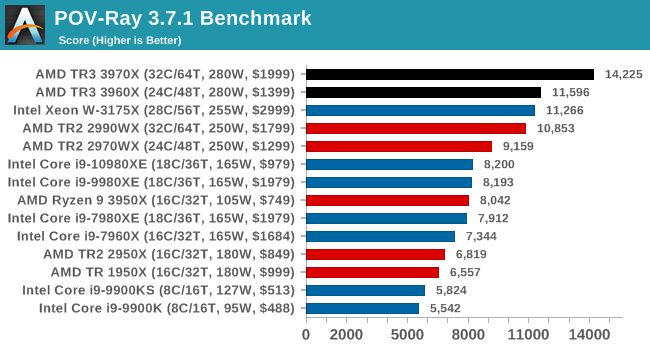The AMD Ryzen Threadripper 3960X and 3970X Review: 24 and 32 Cores on 7nm
by Dr. Ian Cutress, Andrei Frumusanu & Gavin Bonshor on November 25, 2019 9:05 AM ESTCPU Performance: Rendering Tests
Rendering is often a key target for processor workloads, lending itself to a professional environment. It comes in different formats as well, from 3D rendering through rasterization, such as games, or by ray tracing, and invokes the ability of the software to manage meshes, textures, collisions, aliasing, physics (in animations), and discarding unnecessary work. Most renderers offer CPU code paths, while a few use GPUs and select environments use FPGAs or dedicated ASICs. For big studios however, CPUs are still the hardware of choice.
All of our benchmark results can also be found in our benchmark engine, Bench.
Corona 1.3: Performance Render
An advanced performance based renderer for software such as 3ds Max and Cinema 4D, the Corona benchmark renders a generated scene as a standard under its 1.3 software version. Normally the GUI implementation of the benchmark shows the scene being built, and allows the user to upload the result as a ‘time to complete’.
We got in contact with the developer who gave us a command line version of the benchmark that does a direct output of results. Rather than reporting time, we report the average number of rays per second across six runs, as the performance scaling of a result per unit time is typically visually easier to understand.
The Corona benchmark website can be found at https://corona-renderer.com/benchmark

Being fully multithreaded, we see the order here follow core counts. That is except for the 32-core 2990WX sitting behind the 24-core 3960X, which goes to show how much extra performance is in the new TR generation.
Blender 2.79b: 3D Creation Suite
A high profile rendering tool, Blender is open-source allowing for massive amounts of configurability, and is used by a number of high-profile animation studios worldwide. The organization recently released a Blender benchmark package, a couple of weeks after we had narrowed our Blender test for our new suite, however their test can take over an hour. For our results, we run one of the sub-tests in that suite through the command line - a standard ‘bmw27’ scene in CPU only mode, and measure the time to complete the render.
Blender can be downloaded at https://www.blender.org/download/

We have new Threadripper records, with the 3970X almost getting to a minute to compute. Intel's nearest takes almost as long, but does only cost half as much. Again, the 3960X puts the 2990WX in its place.
LuxMark v3.1: LuxRender via Different Code Paths
As stated at the top, there are many different ways to process rendering data: CPU, GPU, Accelerator, and others. On top of that, there are many frameworks and APIs in which to program, depending on how the software will be used. LuxMark, a benchmark developed using the LuxRender engine, offers several different scenes and APIs.
In our test, we run the simple ‘Ball’ scene. This scene starts with a rough render and slowly improves the quality over two minutes, giving a final result in what is essentially an average ‘kilorays per second’.

Our LuxMark test again pushes both TR3 processors out in the lead.
POV-Ray 3.7.1: Ray Tracing
The Persistence of Vision ray tracing engine is another well-known benchmarking tool, which was in a state of relative hibernation until AMD released its Zen processors, to which suddenly both Intel and AMD were submitting code to the main branch of the open source project. For our test, we use the built-in benchmark for all-cores, called from the command line.
POV-Ray can be downloaded from http://www.povray.org/

More rendering, more wins for AMD. More losses for the 2990WX, even though on these tests it still beats the 10980XE quite easily.











245 Comments
View All Comments
zky1 - Monday, November 25, 2019 - link
Too expensive. Anything over $300 for a cpu is a ripoff. See you in two years when these threadrippers are obsolete.peevee - Monday, November 25, 2019 - link
Very likely it is a new plateau enabled by 7nm and brand new Zen architecture developed to its potential. I predict small improvements from here for the next several years as it has been with Intel since Sandy Bridge - only better AVX512 implementation on something like 5nm and DDR5 will bring some improvements, but don't expect wonders on most tasks which don't care about memory throughput or AVX512.Slash3 - Tuesday, November 26, 2019 - link
The upcoming Zen 3 architecture revision is reported to provide up to a ~10% IPC uplift, with some neat tricks such as unifying the L3 cache per chiplet (no more CCX contention).There's always something better around the corner. :)
lobz - Tuesday, November 26, 2019 - link
Nope, it's the CCX size that changes from 4 to 8 cores.peevee - Tuesday, November 26, 2019 - link
"Up to 10%" - exactly what I have meant, a plateau, like Intel had after Sandy Bridge, adding only ~5% each year...Korguz - Tuesday, November 26, 2019 - link
peevee um intel could of improved their ipc more each year.. but they didnt, there was no reason too.. just like they could of given mainstream more then 4 cores.. but they didnt as well.. mostly because of zen.. is there more then 4 cores from intel..catheryn75 - Monday, November 25, 2019 - link
It's too bad they aren't available anywhere other then a few system builders. ie CyberPower , Origin , and others.Some of us who would use one of these new processors dont want to pay the extra 1500-2k for someone else to build it when we could do it ourselves.
AMD was really short sighted not at least having some supply at Newegg, Microcenter, Fry's, etc.. on launch day.
Dug - Monday, November 25, 2019 - link
That's a lot of power needed for 24 cores. 3960 at 280w. And it's recommended to get water cooling? They aren't going to get many buyers on that.6 more cores than Intel 10980, but needs 90w more power to get there.
I thought 7nm would be better than this.
The Xeon is way out of wack at 381.
People that really need the speed to save in man hour costs, expect a high end system with warranty, instant replacement, compatibility (especially vm), and reliability. I don't think you are going to get that with water cooling. And I don't see any major players that offer what I listed, going to a water cooled system anytime soon.
alufan - Tuesday, November 26, 2019 - link
https://www.scan.co.uk/3xs/configurator/amd-thread...pricey though but its liquid cooled
Dug - Tuesday, November 26, 2019 - link
Not exactly mainstream. I'm talking Dell, HP